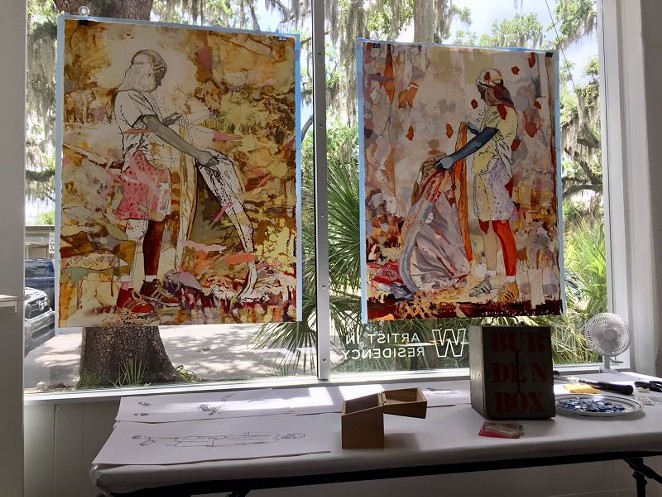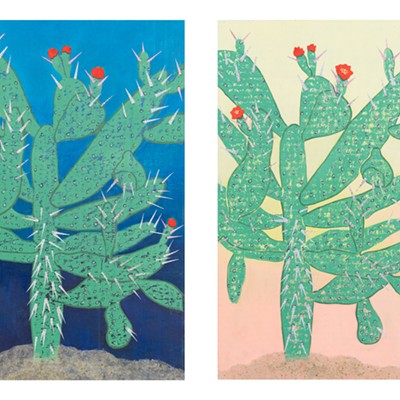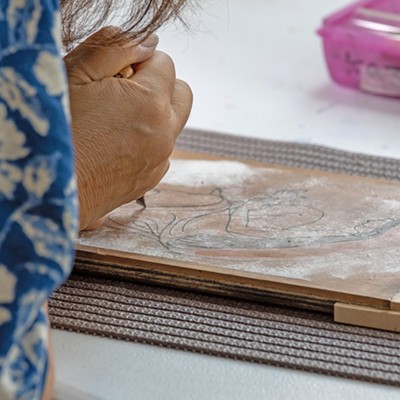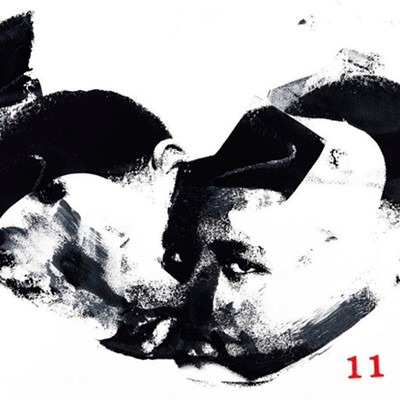LAST MONTH, Sulfur Studios tried something new.
Their front window space, formerly the storefront for The Hidden Hand Society, became vacant. Emily Earl and Jennifer Moss knew they had a unique opportunity with such a promising space.
Enter the ON::VIEW residency, a monthly rotating site-specific project taking place right on Bull Street.
A crucial part of the residency is its requirement of community participation beyond the artist’s presence in the studio. The creativity of the artists in their engagement helps bolster the vibrant arts community Sulfur has dreamed of since day one.
We reached out to the residency’s alums for some insight on their work and their community.
Tell me about the work you make and your usual process.
Becky Slivinsky, June artist: Through my work, I am looking to challenge beauty standards that are questioned by women every day. I look at the media to see how women are represented. In particular, I look for images of women portrayed in magazines and see how women are being portrayed. I use cleaning products to alter the images in the magazine. I am looking to obliterate the woman’s objectification in the advertisement by using these cleaning fluids.
Rob Hessler, March artist: I typically make drawings and sculptures, usually in a very solitary way in my studio.
Page Laughlin, May artist: I am primarily known as a painter, though through the years I create site- specific public interventions and alternative media drawings. My most recent artworks, in the past 5 years, are part of a collection I call the Coloring Book Portfolio. These works are an intersection between photography, digital drawing and painting. I convert photographs into line drawings that are a hybrid between digitally-generated and hand-rendered. I am looking for a particular quality between the glitches that occur with “hand production” and the “coolness of machine made.” These drawings become the template, or the constraint, into which I paint—a “grown-up” version of a coloring book process.
Anya Mitchell, April artist: I’m not sure if a have a usual process per-se; everything I do is inspired by a desired to learn. I have an idea of something I want to make that I think might be beautiful and try to figure out how to make it. I also have a desire to endow the objects I make with meaning.
I usually start with a clear idea of what it is I want to make, and then through the process, as I learn about the material more ideas come of how to push the work further and the possibilities that exist.
Michelle Quick, July artist: I consider myself a designer and craftsman more than an artist because I primarily make functional products that blend traditional craft techniques with modern design. I design and make shoes, bags, and leather goods. My usual process consists of working with clients to design and make custom products that balance their functional needs and preferences with my design ideas, so there is a lot of problem-solving and reworking.
What was your approach to the residency? How did your work differ, if it did, from your regular process?
BS: Throughout the residency, I really was looking to continue the body of work that I have been working on throughout the past year, but I wanted to make art that is accessible to the community, affordable and goes to an amazing cause, Planned Parenthood Southeast Associates.
RH: There are a couple of different factors here. First, unlike my normal process, the Hindenburg project that I did for the residency required that I bring in collaborators who had expertise at the things that I had little to no experience doing. It was a performance art piece with video elements, so I brought in videographer Drew Hunt and director Chris Soucy to help me realize my vision. But they really took the idea and ran with it, adding so much more than I could have even imagined. And Chris brought in some truly fantastic actors that, again, elevated the project even further. And actually creating the performance space, which I did myself, was a bit surreal. My normal studio space is, like I said, secluded. I utilize artificial light to mimic the feel of a gallery, because that’s where a lot of my work will end up. But in the space at Sulfur, I was really exposed. The windows look out onto Bull Street, so there was always someone walking by, looking in. And Sulfur is so full of energy that there were always people coming through, wanting to chat about what I was doing, or just to introduce themselves. It couldn’t have been more different than what I normally do.
PL: I was looking for a community in which to launch the Community Coloring Book Project, to run a project through its initial experiments—a “living laboratory,” so to speak. Sulfur Studios and Savannah provided the most fantastic opportunity. As an artist from outside the region, I faced simple questions of mechanics such as: What is it like to enter into a new community? How do I raise awareness of the project in a very short period of time? Will people willingly participate? How many resources (time, space, materials, equipment, etc.) will I need to photograph and then convert images into drawings for printing? But there are deeper, ongoing questions as well: how do you proscribe “community”? What does it mean for an individual to contribute their image? What is my responsibility when I edit out details to create a more open image? The process-oriented nature of the residency program, the public nature of the space, and the open character of Savannah’s residents all made the project’s launch successful beyond my imaginings.
AM: For the residency, I really tried to involve as many people as possible due to the encouragement of community engagement from the folks at Sulfur. I looked for opportunities for people to assist me. Like, my brother-in-law helped me build the frames for the final pieces, my sister painted neighborhood map of Savannah for visitors to interact with, my boss let me borrow a rug to warm up the studio space, my friend assisted me with the school group that came to visit the studio, my co-worker let me borrow his camera and showed me how to use it, another co-worker assisted me with the printing of my images, another friend let me borrow their projector and another friend painted a mini-mural in the studio. I looked for ways to work with others in pushing their own talents further. I just felt like I was given this great opportunity to try something I hadn’t done before and I wanted to take that opportunity and share it with others as much as possible. I also knew very little of all the things I wanted to do, so I really needed assistance to accomplish what I envisioned.
MQ: One of the reasons I am most excited about this residency is that it’s allowing me to take a different approach to my work. My creation process utilizes the same skills and processes I use when teaching or working with clients but I’m focusing on highlighting the materials and hand techniques rather than function and meeting specific outcomes. There is a lot more experimentation and just trying to convey the intrinsic value of the materials and the complexities of the hand processes involved in making the products. The final outcome won’t just be several pairs of shoes, but a physical display that shows all the raw materials, processes, and the finished product.
How did you tie in community participation?
BS: Almost every afternoon I was in the studio with the door open so the community could come in and chat. It was important to me to get the community’s perspective on my work and if they felt they could relate to it. In addition, my public reception benefitted Planned Parenthood Southeast Advocates. Planned Parenthood is so important and essential to men and women of all ages, and it was important to me that I help out their cause in any way that I could.
RH: Since it was a performance art piece, the ultimate goal was to create a show for the First Friday crowd to view through the window. We set up audio out on the sidewalk, and advertised two performances that night. And people showed up. I was honestly shocked at how many people were gathered around those windows. It just goes to show you how great a job the folks at Sulfur Studios and the Starland Design District as a whole have done at building the art scene in that area.
PL: The community is the Community Coloring Book Project; community engagement creates and defines it. In a month’s time, I was able to learn and accomplish so much more than expected. I found Savannah to be such a fascinating town, with the diversity of a large city and the connections of a small town. Within a few blocks one comes across a whole spectrum of individuals with different dreams, interests, and concerns. For a “stranger” coming in, I found the city to be remarkably open. People were excited to contribute their image to the coloring book project. I think there is a wonderful sense of pride in this city—not blind, but a pride that comes with awareness of the positive and the negatives. This awareness and acceptance impressed me.
The Residency gave me a storefront public space to operate from, but I also walked the town, chatted up people in shops, met people for cup of coffee, stopped in the parks, etc. Delightfully, the community also reached out. It was wonderful to have the school kids and their teachers come spend an afternoon on site, as well. And the drawings I was able to complete during the residency, I gave back to the participants. I realize I need about 9-12 months for full realization of the Community Coloring Book Project, but the experience of launching the project at Sulfur Studios was like double-time in the richness of the experience.
AM: I had open studio times every Saturday for the public to stop in and see the progress I was making and show them a demo on paper weaving. When I was up in Chicago for temporary work, I noticed a few artist in Evanston had events where people would come together to talk about different issues that faced their community. In these spaces the artist would have a project for everyone to participate in making and it somehow seemed like it was easier to listen for everyone to talk while people were busy with their ideas and stitching a quilt square. I wanted to try something similar to this with my residency, because why not try and learn?
MQ: As someone who is involved in the fashion industry, both as a designer and an educator, it’s becoming harder to ignore the negative impact of globalized production and low-cost manufacturing, both in terms of the resources it requires and the exploitative practices that can affect the people making all of these products. I believe that it’s becoming more common for people to consider how the products they choose to buy are produced and I wanted to further that conversation in Savannah specifically about footwear and leather goods. By showcasing the materials and processes that go into making shoes at the handmade level, I hope to facilitate a discussion about the value of fashion products and the people that create them in mass quantities.
What did participating in the residency do for you? Did you experience any additional visibility or engagement afterwards?
RH: The project was part of my larger “Other Side of the World” series which a lot of people already had some sense of, and because of the tremendous turnout I feel like it got even more people on board with what I’m doing. I was especially encouraged by who showed up to the event, which included a number of people who I greatly admire. I also had a museum curator come to me afterwards and say that they’re going to be following my work because of that piece, which was nice.
PL: I got great exposure during the residency through media outlets like Art on The Air and the social media presence of Sulfur Studios and ON::View Residency. I had some really great interviews, both the formal on-air ones, interviews for upcoming podcasts, as well as interviews with school kids. The questions and conversations have continued to fuel my thinking about, and the evolution of, the Community Coloring Book Project.
AM: Definitely. The people following me on Instagram went up and I was interviewed by the guys that produce “Art on the Air” podcast. I also met a lot more working artist and have been able to connect with them and learn from them.
Why is a residency like this important for your community? Why is it important for you?
BS: I think that my particular residency was important to the community because my work surrounds a topic that many people might not know how to approach. People who see it might start to feel more comfortable discussing the objectification of women when artwork sparks the discussion. Also, Planned Parenthood is an amazing organization, and I am happy to help in any way that I can. We need to keep fighting for what is right and I hope that my contribution helps somebody in some way.
RH: One of the things that I truly love about this residency is that participants are required to live within a certain distance of Savannah. It’s specifically designed to showcase local artists. Savannah is an emerging art scene with limitless potential. But it needs support to continue to grow, and this residency not only shows amazing projects, but it says to the viewing public that we don’t need to go anywhere else for great art.
Personally it gave me an opportunity to explore and grow as an artist. It’s made me more interested in collaboration, more engaged with other local artists, and it took me out of my comfort zone in a very meaningful and important way. I feel as though I’m not only a better artist for having done my Hindenburg project with them, but also a better person overall for the experience.
PL: A thriving community is fueled by creativity. One needs only to look at Savannah—a city teaming with creatives—to see this impact. But access to creative process, as well as witnessing creative “products,” is truly essential. By providing opportunity for members of a city to engage in the most direct manner with creative process opens minds, educates individuals, and connects us. The palpable experience of direct and open contact with creative process is rare and, I think, increasingly important.
AM: I think it’s another space in which people can learn. They might be exposed to a new technique that the artist uses, or learn more about concepts presented in the art work. Like [in June] Rebecca Slivinksy’s work focused on women’s rights and the concept of beauty/objectification of women, and this month there is a cobbler sharing her expertise and also setting up a panel discussion regarding this skill-set. I think it’s a space where meaningful, diverse conversations take place. It’s a place where knowledge is shared. For me it’s important because I love learning through conversations, or people sharing with me their innate knowledge about a material, and I know each time I go to the ON::VIEW residency there is always someone down to talk and share. It also gives me another chance to run into people and slowly, hopefully, build a community.
MQ: The residency is providing me with a platform to engage the Savannah community and showcase the rare craft of shoemaking. I think it’s important for the Savannah design community to consider and discuss the changing landscape of the fashion industry and how we can collectively be a part of positive change.































